I was lucky enough to draw four illustrations for the Tuyo World Companion, which is (as indicated by the title) a companion book for the Tuyo series by Rachel Neumeier. I love this series, so I was excited when Rachel tossed around the idea of a world-building book on her blog, even more excited when she invited me to provide feedback on an early version, and absolutely thrilled when she liked the sketches I showed her enough to want to include my art in the book.
If you’re not familiar with the series, the companion book is probably not the place to start. Even if you really, really love reading world-building and behind the scenes content, I suggest reading some of the stories first. I think Rachel recommends Tuyo at a minimum, but in my opinion, a lot of the encyclopedia-like portion won’t make much sense unless you have read all three books in the Tuyo–Tarashana–Tasmakat trilogy, and the novella included at the end (which I loved!) will be better if you have read Tano too. (So yes, this is a blog post basically saying, “Look at these pictures I drew – oh, but you have to read four other books first, and one of them is extremely long!”)
Anyway, like the Tuyo World Companion, the rest of this blog post will make more sense if you have read Tuyo. I drew four pictures for the book (not the maps, someone else did those!) and I wanted to share sketches and detail shots from two of them. Before we get into it, I probably should say that I don’t think anybody should take my thoughts as 100% absolute canonical truth – sure, my illustrations are in the book, but all that means is that my version was close enough to Rachel’s vision that it wasn’t worth another round of revisions. Personally, I’ve been thinking of them as secondary sources: pictures drawn by somebody (me) who talked to an eyewitness (Rachel).
Ugaro Weaver and Blanket
I had fun with all the illustrations, but I think my favorite is the Ugaro weaver. I’ll save the full final version for the book, but here’s my initial sketch, some planning/design work, and a little zoomed in detail shot:
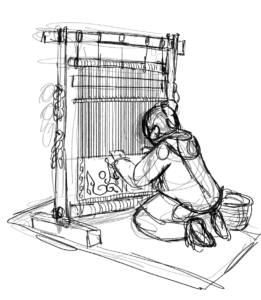
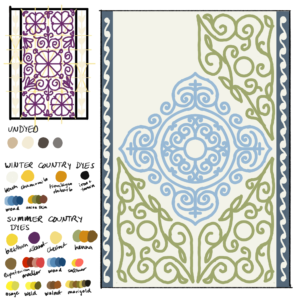
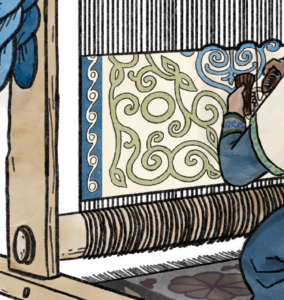
I started with the little color swatches in the bottom corner of the second image. I knew I wanted to draw an Ugaro blanket, and because this book is for the readers who care about all the little world-building details, I felt like I couldn’t possibly start until I knew what sorts of materials an Ugaro weaver would have access to when she sat down to design a blanket. I found a big long list of natural dyes online, and I went through them all one by one, googling the plants (or bugs) and deciding where they would live in Tuyo-world (I relied very heavily on Wikipedia, and made snap judgements for most of them, so I’m sure somebody could make a case that I have misclassified some of them). The picture in this post shows the colors that I thought would be pretty easily available from foraging in the winter country or by trading with the Lau, but my full list does include the country of sand and farther off parts of the summer country. That gave me a general sense of what the available palette was, and which colors would be cheap (and therefore common in everyday textiles) or expensive (and therefore more likely to show up only in smaller amounts, or in special textiles for important people).
The next thing I thought about was the weaving process and loom technology. The Ugaro are nomadic, so their looms need to be portable, and since blankets and rugs don’t really seem like distinct categories in the stories, I have always imagined a single multipurpose class of flat-woven textiles. With those two features in mind, I did some research into the looms and weaving techniques of both Navajo and kilim rugs. One of the things I like so much about this series is that it’s never so straightforward as “this group of people is just a fantasy version of some real-world culture” – it’s always more like a detail from here, an idea from there, and plenty of stuff straight from Rachel’s imagination. I wanted to keep that up in the illustrations, so the loom in the picture has some features I saw on images of Navajo looms, some features I saw on kilim looms, and a couple other details and modifications that I made up.
Once I knew what colors and what kind of loom an Ugaro weaver would have, I was ready to design the blanket. I looked up decorative textiles from cultures living in cold climates all around the world, and decided to draw my inspiration mostly from keste, or Kazakh embroidery, because it was abstract and intricate (which fit the descriptions of Ugaro textiles), and because I just really liked it. I didn’t copy any particular design or object, instead I tried to just draw my own thing while having a lot of keste images up on my screen in the background.
The first blanket design I did was the blue, green, and cream blanket. I chose the colors because Rachel says in the Tuyo World Companion that the Ugaro consider blue and green to be feminine colors, and because this is supposed to be an ordinary, every day sort of blanket, so I wanted to use mostly “cheaper” colors. The blank space in the top left is intentional, because I was imagining the central blue medallion as representing the moon, and the three surrounding green designs as the Dawn Sisters (of which I’m pretty sure there are three – I didn’t actually look it up to check, it will be embarrassing if I have misremembered!). I wasn’t quite sure about having such a large, asymmetric blank space in the design, but since I didn’t include the full blanket in the final illustration, I didn’t actually have to decide if I liked that choice.
Later, after I had worked out most of the illustration, I realized I needed another design to fill in the blanket the weaver was sitting on, and I quickly threw together the purple and gray design. The thought process there was a little less involved – I have no ideas about the symbolism of this design, and I chose the colors just because Rachel had said the Ugaro use a lot of purple and I wanted something dark on the ground.
If you know anything about weaving, you will probably be wondering about the vertical borders on these blankets. Long vertical lines don’t come naturally in kilim or Navajo style flat weaving. Usually the weft yarns wrap back around at the edges of a block of color, so if you have two blocks with a long vertical border between them, it will make a vertical hole in the blanket. However, I really wanted the Ugaro rugs to have an obvious design feature that is not common in any particular school of real-world weaving, so I decided that vertical borders made by double-clamping or interlocking would be a near-universal feature of Ugaro rugs (at least when I draw them, Rachel does not necessarily agree with all of my theories and opinions about Ugaro weaving techniques).
Something else that will be obvious to fiber artists (but maybe not other people), is that there is a mismatch between the number of warp threads I drew and the fineness of the curves in the rug design. If there were really that few warp threads, the shapes on the rug should be much blockier. This is kind of an artifact of the drawing style: I couldn’t fit any more warp threads without making the lines narrower, but a very narrow line width on the threads looked out of place with the rest of the image; similarly, trying to make the design just a little bit blockier also looked wrong because it seemed like a higher level of detail and realism than the rest of the image. So, in my mind, the truth is somewhere in between – the imaginary “real” blanket has more warp threads than shown, but the curves aren’t quite as smooth as in the drawing.
There is of course also a person in the illustration, but as I’m sure you can tell, I am a big fiber arts nerd and my true love here is the blanket that is barely shown in the final image, so I have a lot less to say about the weaver! She is intended to be sort of an Ugaro everywoman – she is certainly not Darra, Marag, Etta, or anyone else important we have met. Her clothes and hair are based on descriptions from the Tuyo World Companion and in the final couple scenes of Tasmakat, and on some reference photos I found of Inuit women online.
The Break
This post is already much longer than I thought it would be, so I’ll keep things short for the second image. The other illustration I really sunk a lot of time into is the drawing of the Break. The original sketch I showed Rachel is on the left; as you can see, I just plopped some very American looking houses on the Lau side and called it a day. I knew the buildings were wrong when I did it, but at that point, I was just drawing for fun and I was more interested in the two different landscapes butting up on each other, so all I really wanted was kind of a placeholder “there are people here” image.
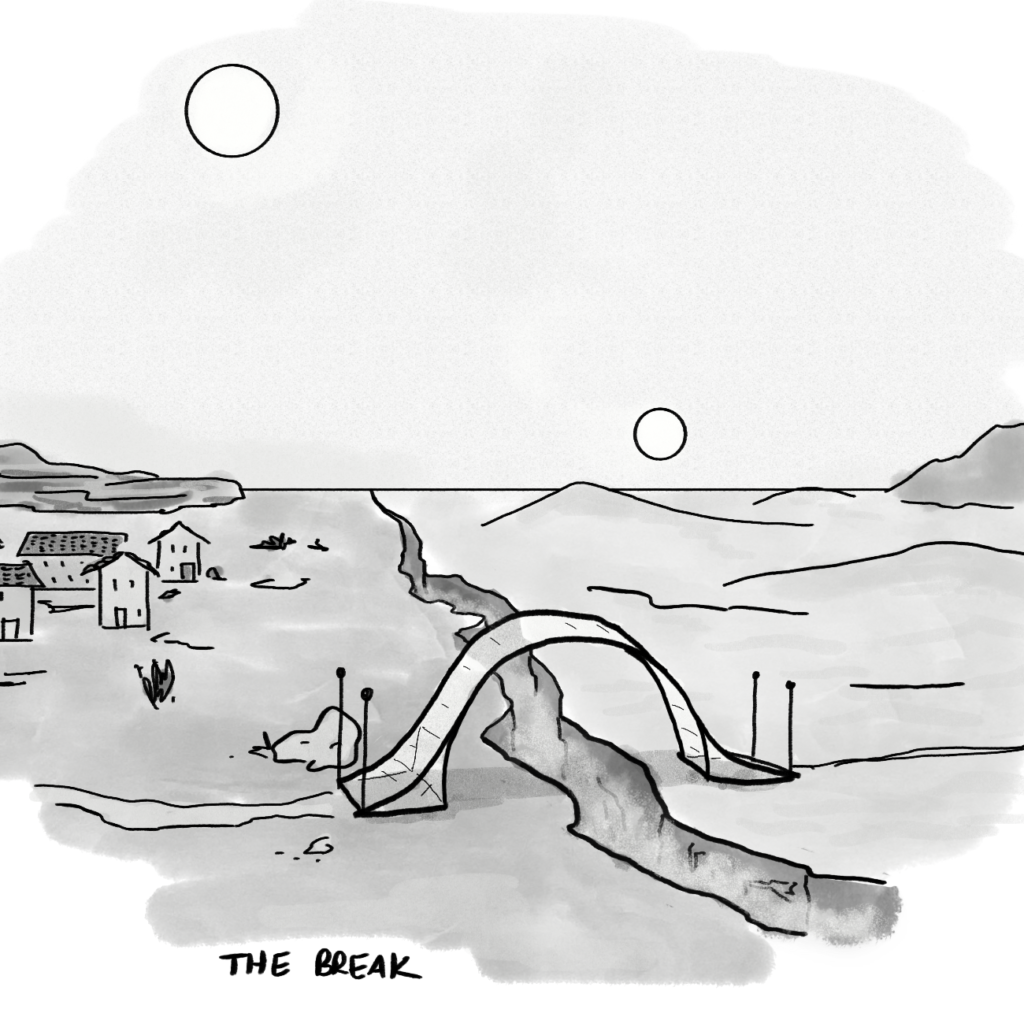
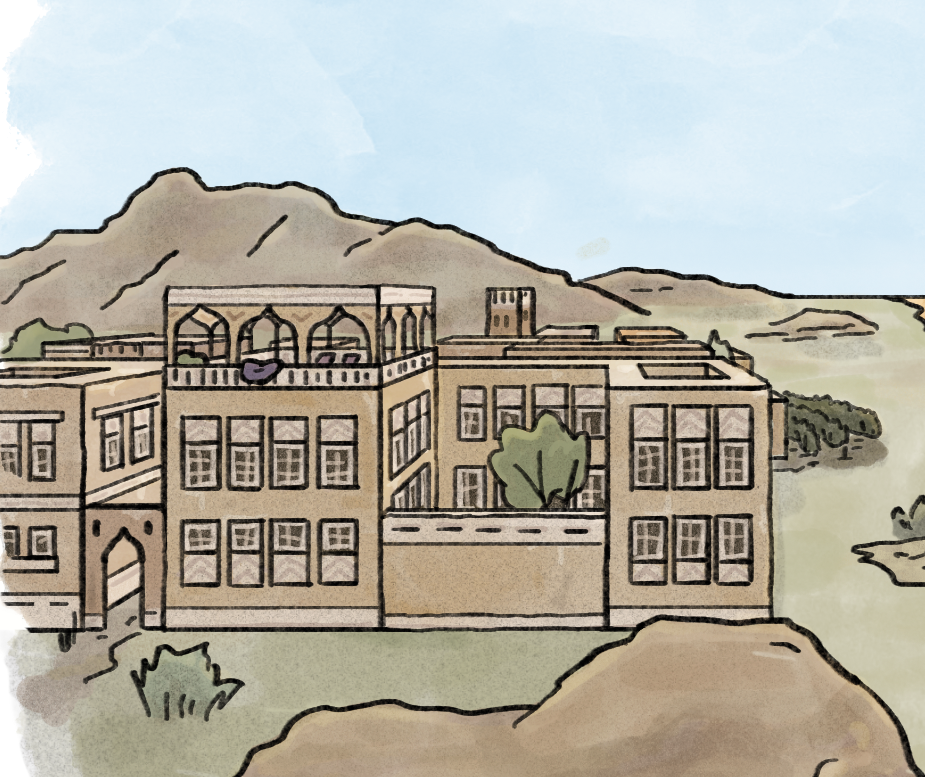
I knew I wasn’t quite putting the pieces of description together correctly, and that if I wanted to do it right, I would have to go back and read them over carefully and then find reference images. Rachel actually saved me a bunch of time by providing some reference images, and then I looked up more images of those cities (Al-ula, Saudi Arabia and Sana’a, Yemen), and wow, everything is so much easier when you’re looking at the right references! The picture on the right is a very, very zoomed in detail view of the Lau town in my final illustration of the Break. It still has a couple things I am not perfectly happy with, but it’s so much better! I’m really pleased with how this came out, I think it does a good job suggesting a lot more than what’s actually there. (You can also compare it to another artist’s vision of a different Lau town on the cover of an upcoming book here on Rachel’s blog.)
The other thing that was very fun in both of these illustrations was the challenge of trying to draw something that looks handmade and well-used. For both the Ugaro loom and the Lau town, I used perspective grid tools to draw a very crisp and clean version (you can find a process video of the Lau town on my instagram), and then went back and roughed things up to add age and detail. This two-step process is something I don’t really do when drawing from life, because the imperfections are already there, but I find that I can’t design an object and think about how it would age at the same time, so I have to draw an idealized version first. Adding the imperfections is one of my favorite steps, because it really makes something drawn from the imagination look like it might have been drawn from life.
In conclusion: I love these books, I loved drawing these illustrations, if anybody reading this is a fantasy author working on a world-building companion book and wants some illustrations, please consider me for the job.
